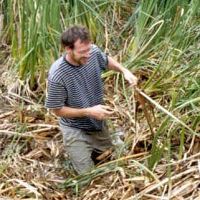Bales et al., 2015
Drought effects on evapotransiration and subsurface water storage in the southern Sierra Nevada.
Bales, R., Goulden, M., Hunsaker, C., Conklin, M., Hartsough, P., O’Geen, A., Hopmans, J., Safeeq, M. (2015)
H33M. The Hydrology-Vegetation-Climate Nexus: Identifying Process Interactions and Environmental Shifts in Mountain Catchments II, presented at 2015 Fall Meeting, AGU, San Francisco, CA, 14-18 Dec.
-
Sierra, INVESTIGATOR
-
Sierra, INVESTIGATOR
-
Sierra, INVESTIGATOR
-
Sierra, INVESTIGATOR
-
Sierra, COLLABORATOR
-
Sierra, INVESTIGATOR
-
Sierra, INVESTIGATOR
Abstract
Multi-year measurements of evapotranspiration (ET) at three elevations in the southern Sierra Nevada show the extent to which subsurface water storage in the regolith provides a buffer against multi-year dry periods. ET in a 2000-m elevation mixed-conifer forest showed a 24% decrease in ET in water-year 2014, the third dry year, as compared to the wet year of 2011. This decrease reflected reduced transpiration for the July to September period. Over half of the annual ET in both wet and dry years came from below the 1-m depth mapped soil, and with come coming from below the 2.5 m depth of our soil-moisture measurements. The ability of trees to access water from these depths does provide a 2-3 year buffer for ET, which also depends on forest density and the balance between perennial overstory and annual understory vegetation. An equally dense lower-elevation pine-oak forest (1160 m) showed nearly a 50% decrease in ET during the third year of drought, with significant visible effects on vegetation. While this lower elevation forest may have as much or more subsurface storage as does that at 2000-m elevation, the combination of lower precipitation as one goes down in elevation and very high forest density provides only a one-year buffer for ET in dry years. Regaining resiliency in this forest will only occur with significant reductions in biomass and commensurate lowering of ET. In a 400-m elevation oak savannah ET responds to annual precipitation, with essentially no multi-year buffer provided by subsurface storage.
Citation
Bales, R., Goulden, M., Hunsaker, C., Conklin, M., Hartsough, P., O’Geen, A., Hopmans, J., Safeeq, M. (2015): Drought effects on evapotransiration and subsurface water storage in the southern Sierra Nevada. H33M. The Hydrology-Vegetation-Climate Nexus: Identifying Process Interactions and Environmental Shifts in Mountain Catchments II, presented at 2015 Fall Meeting, AGU, San Francisco, CA, 14-18 Dec..
Explore Further







